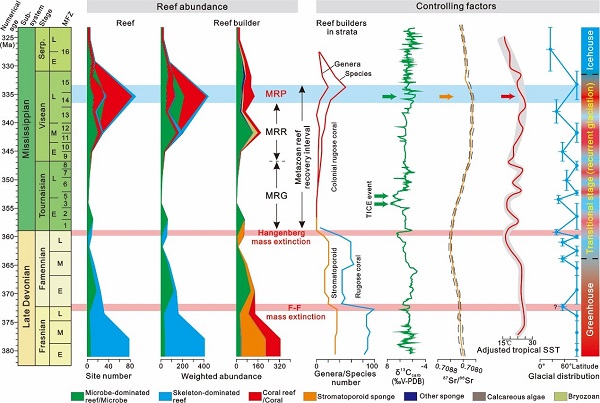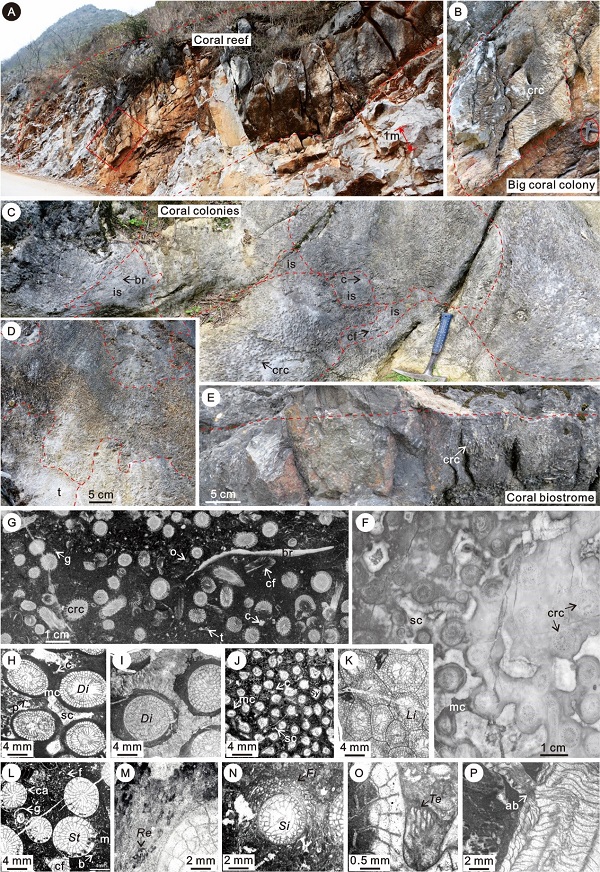Reefs are important marine ecosystems in marine, and an excellent tool for tracking marine ecosystem changes, especially through mass extinction transitions. During the geological history, the earliest marine reef ecosystems were formed of stromatolites and flourished during the Precambrian before declining in the Phanerozoic. Metazoan reefs first appeared in the late Ediacaran and proliferated during the Phanerozoic, albeit with time gaps after mass extinction events, which are often marked by microbial reef proliferation.
During the Middle-Late Devonian, the largest area of metazoan (stromatoporoid-coral) reefs of the Phanerozoic occurred, which covered about five million square kilometres (10 times the surface area of modern reef ecosystems). The Late Devonian Frasnian-Famennian (F-F) Kellwasser and the end-Devonian Hangenberg extinctions caused the collapse and disappearance of stromatoporoid-coral ecosystems, respectively. The succeeding Mississippian has long been assumed to be an interval dominated by microbial reefs, and lack of metazoan reefs. Small-sized metazoan reefs gradually reappeared during the middle-late Mississippian (Visean Stage). However, due to low-resolution and limited data available in previous studies, the timing and style of metazoan reef recovery in the Mississippian are unclear.
Recently, Dr. YAO Le from the Nanjing Institute of Geology and Palaeontology, Chinese Academy of Sciences (NIGPAS), Dr. Markus Aretz from the University of Toulouse 3, and Prof. Paul, B. Wignall from the University of Leeds, systematically reviewed and documented the reef composition, distribution and evolutionary process from the Late Devonian to Mississippian, and uncovered the re-emergence of the Mississippian coral reef ecosystems after the Late Devonian mass extinctions. Relevant findings were published online on 16th December, 2019 in Earth-Science Reviews.
Previous reports of the late Visean coral bioconstructions from the Western Europe and North Africa (western Palaeotethys Ocean), may mark the first metazoan reef proliferation after the Hangenberg extinction. In this study, abundant coral reefs, coral frameworks and coral biostromes were described from the late Visean strata on the South China Block (eastern Palaeotethys Ocean). The occurrence of these coral bioconstructions further suggests that the late Visean coral reef recovery may have been a widespread phenomenon.
Based on the high-resolution reef database constructed in this study, three sub-intervals of the Mississippian metazoan reef recovery were distinguished, which are (1) metazoan “reef gap” phase (MRG) without metazoan reefs during the Tournaisian; (2) metazoan reef re-establishment phase (MRR) containing a few metazoan reefs from early Visean to early part of the late Visean; and (3) metazoan reef proliferation phase (MRP) with global coral reef flourishment during the middle part of the late Visean (late Asbian to early Brigantian substages).
Coral reef proliferation at this time showed that the Mississippian was not solely a period dominated by microbial reefs. Late Visean coral reef development coincided with increased nektonic and benthic diversity, showing that stable marine ecosystems developed during this time.
Even compared with other slow reef-recovery intervals, such as the middle-late Cambrian and Early-Middle Triassic with the intervals until the MRR and MRP of 5 Ma and 2 Ma, and 15 and 9 Ma respectively, the Mississippian metazoan reef recovery was the longest in reef history with about 12 Ma and 23 Ma until the MRR and MRP, respectively. Harsh climatic and oceanic conditions were present during the Mississippian, mainly including the widespread marine anoxia during the middle part of Tournaisian and the following recurrent glacial and interglacial climatic episodes with frequent changes in sea level, sedimentary facies and sea-water surface temperature, which may have stymied metazoan reef recovery during this time. During the late Visean, marine communities flourished during a phase of relative warm conditions and high sea level, and coincided with the long-delayed re-emergence of coral reef ecosystems after the Late Devonian extinctions.
This research was supported by the Strategic Priority Research Program (B) of the Chinese Academy of Sciences, the National Natural Science Foundation of China, and the Natural Science Foundation of Jiangsu Province.
Article information:Yao, L*., Aretz, M., Wignall, P.B., Chen, J.T., Vachard, D., Qi, Y.P., Shen S.Z., Wang, X.D., 2019. The longest delay: Re-emergence of coral reef ecosystems after the Late Devonian extinctions. Earth-Science Reviews. DOI: https://doi.org/10.1016/j.earscirev.2019.103060.

Composition and evolutionary pattern of the Late Devonian to Mississippian reefs, and their relations to coeval changes in reef builders and palaeoenvironments

Field (A-E), polished-slab (F-G) and thin-section photographs of the late Visean (Mississippian) coral reefs in South China

Field photographs of the late Visean coral reefs from other areas, e.g., Morocco (A), England (B-D), Australia (E) and Japan (F)
Download:
